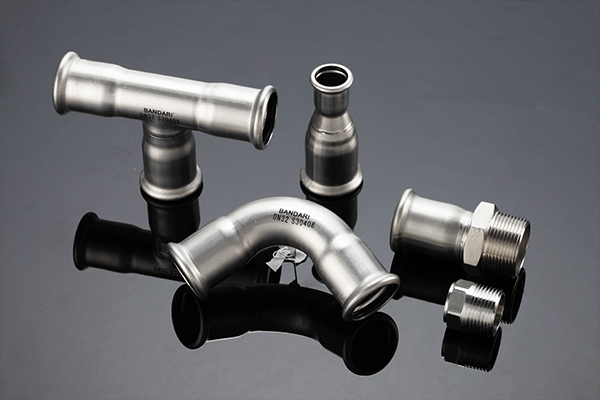Do you know the role of each chemical composition in the composition of stainless steel welded pipe materials? You may only know part of it. Stainless steel welded pipe is composed of various chemical elements, and these chemical elements have a relatively large impact on the performance of stainless steel welded pipe Yes, the following stainless steel welded pipe manufacturers will give you an analysis of how various chemical components affect the performance of stainless steel welded pipe?

1. The influence of phosphorus (P) chemical elements on stainless steel welded pipes:
In general, phosphorus is a harmful element in stainless steel welded pipes, which increases the cold brittleness of stainless steel welded pipes, deteriorates the welding performance, reduces the plasticity, and deteriorates the cold bending performance. Therefore, the phosphorus content in stainless steel welded pipes is generally required to be less than 0.045%, and the requirements for excellent stainless steel welded pipes are lower.
Second, the influence of sulfur (S) chemical elements on stainless steel welded pipes:
Sulfur is also a harmful element under normal circumstances. Make the stainless steel welded pipe produce hot brittleness, reduce the ductility and toughness of the stainless steel welded pipe, and cause cracks during forging and rolling. Sulfur is also detrimental to welding performance and reduces corrosion resistance. Therefore, the sulfur content is usually required to be less than 0.055%, and the high-quality stainless steel welded pipe is required to be less than 0.040%. Adding 0.08-0.20% sulfur to the stainless steel welded pipe can improve the cutting workability, which is usually called free-cutting stainless steel welded pipe.
3. The influence of chromium (Cr) chemical elements on stainless steel welded pipes:
In structural stainless steel welded pipes and tool stainless steel welded pipes, chromium can significantly increase the strength, hardness and wear resistance, but at the same time reduce the plasticity and toughness. Chromium can also improve the oxidation resistance and corrosion resistance of stainless steel welded pipes, so it is an important alloy element of stainless steel welded pipes and heat-resistant stainless steel welded pipes.
4. The influence of carbon (C) chemical elements on stainless steel welded pipes:
The carbon content of the stainless steel welded pipe increases, the yield point and tensile strength increase, but the plasticity and impact resistance decrease. When the carbon content exceeds 0.23%, the welding performance of the stainless steel welded pipe deteriorates, so the low alloy structure used for welding Stainless steel welded pipe, the carbon content generally does not exceed 0.20%. High carbon content will also reduce the corrosion resistance of stainless steel welded pipes. High-carbon stainless steel welded pipes in open yards are prone to rust. In addition, carbon can increase the cold brittleness and aging sensitivity of stainless steel welded pipes.
5. The influence of nickel (Ni) chemical elements on stainless steel welded pipes:
Nickel can improve the strength of stainless steel welded pipes, while maintaining good plasticity and toughness. Nickel has high corrosion resistance to acid and alkali, and has anti-rust and heat resistance at high temperature. However, since nickel is a scarce resource, other alloy elements should be used instead of nickel-chromium stainless steel welded tubes.
Sixth, the influence of molybdenum (Mo) chemical elements on stainless steel welded pipes:
Molybdenum can refine the grain of stainless steel welded pipe, improve the hardenability and thermal strength performance, maintain sufficient strength and creep resistance at high temperature (long-term stress at high temperature, deformation, called creep) The addition of molybdenum to the structural stainless steel welded pipe can improve the mechanical properties. It is also possible to suppress the brittleness of the alloy stainless steel welded pipe due to fire. Redness can be improved in tool stainless steel welded tubes.
Seven, the influence of titanium (Ti) chemical elements on stainless steel welded pipes:
Titanium is a strong deoxidizer in stainless steel welded pipes. It can make the internal structure of the stainless steel welded pipe dense, refine the grain force; reduce the aging sensitivity and cold brittleness. Improve welding performance. Adding appropriate titanium to the chromium 18 nickel 9 austenitic stainless steel welded pipe can avoid intergranular corrosion.
Eight, the influence of vanadium (V) chemical elements on stainless steel welded pipes:
Vanadium is an excellent deoxidizer for stainless steel welded pipes. Adding 0.5% vanadium to the stainless steel welded pipe can refine the structure grains and improve the strength and toughness. The carbide formed by vanadium and carbon can improve the resistance to hydrogen corrosion under high temperature and high pressure.
Nine, the influence of tungsten (W) chemical elements on stainless steel welded pipes:
Tungsten has a high melting point and a high specific gravity. It is an alloy element of nobility. Tungsten and carbon form tungsten carbide with high hardness and wear resistance. Adding tungsten to the stainless steel welding tube of the tool can significantly improve the red hardness and thermal strength, and is used as a cutting tool and a forging die.
10. The influence of niobium (Nb) chemical elements on stainless steel welded pipes:
Niobium can refine grains and reduce the overheating sensitivity and tempering brittleness of stainless steel welded pipes, and increase strength, but the plasticity and toughness decrease. Adding niobium to ordinary low alloy stainless steel welded pipes can improve the resistance to atmospheric corrosion and hydrogen, nitrogen, and ammonia corrosion at high temperatures. Niobium can improve welding performance. Adding niobium in austenitic stainless steel welded pipe can prevent intergranular corrosion. material.
11. The influence of copper (Cu) chemical elements on stainless steel welded pipes:
Stainless steel welded pipes Stainless steel welded pipes made from Daye ore often contain copper. Copper can improve strength and toughness, especially atmospheric corrosion performance. The disadvantage is that hot brittleness is easy to occur during hot working, and the plasticity of copper content is significantly reduced when it exceeds 0.5%. When the copper content is less than 0.50%, it has no effect on weldability.
12. The influence of nitrogen (N) chemical elements on stainless steel welded pipes:
Nitrogen can improve the strength, low temperature toughness and weldability of stainless steel welded pipes, and increase the aging sensitivity.






